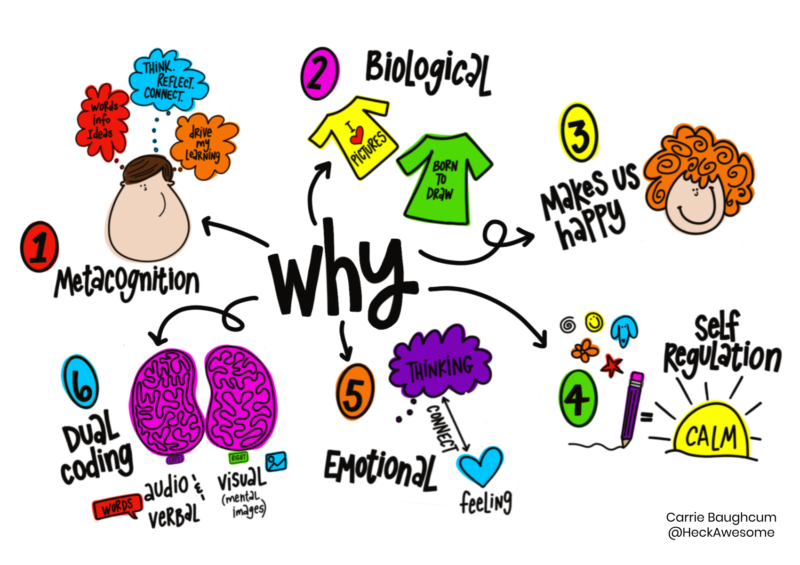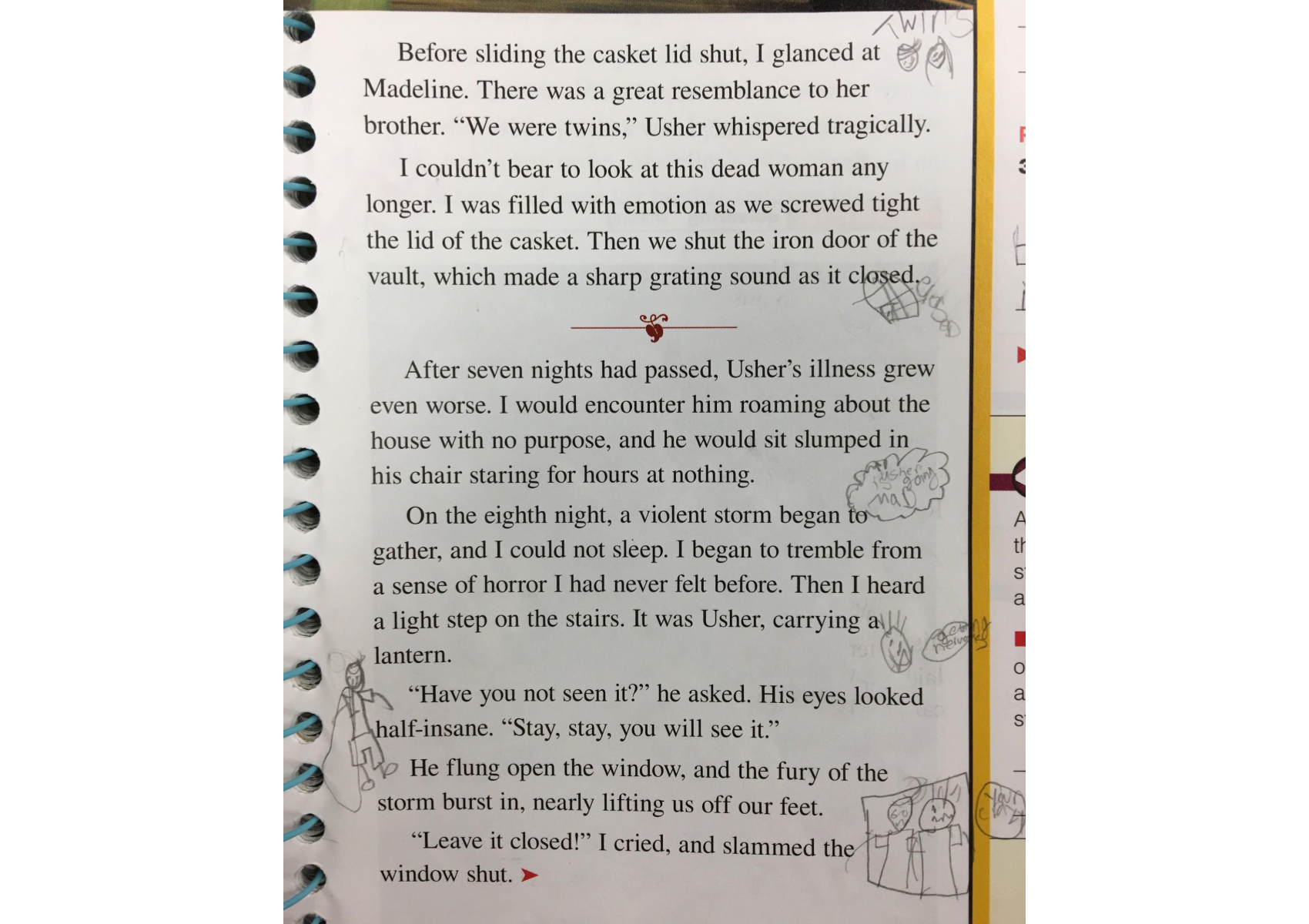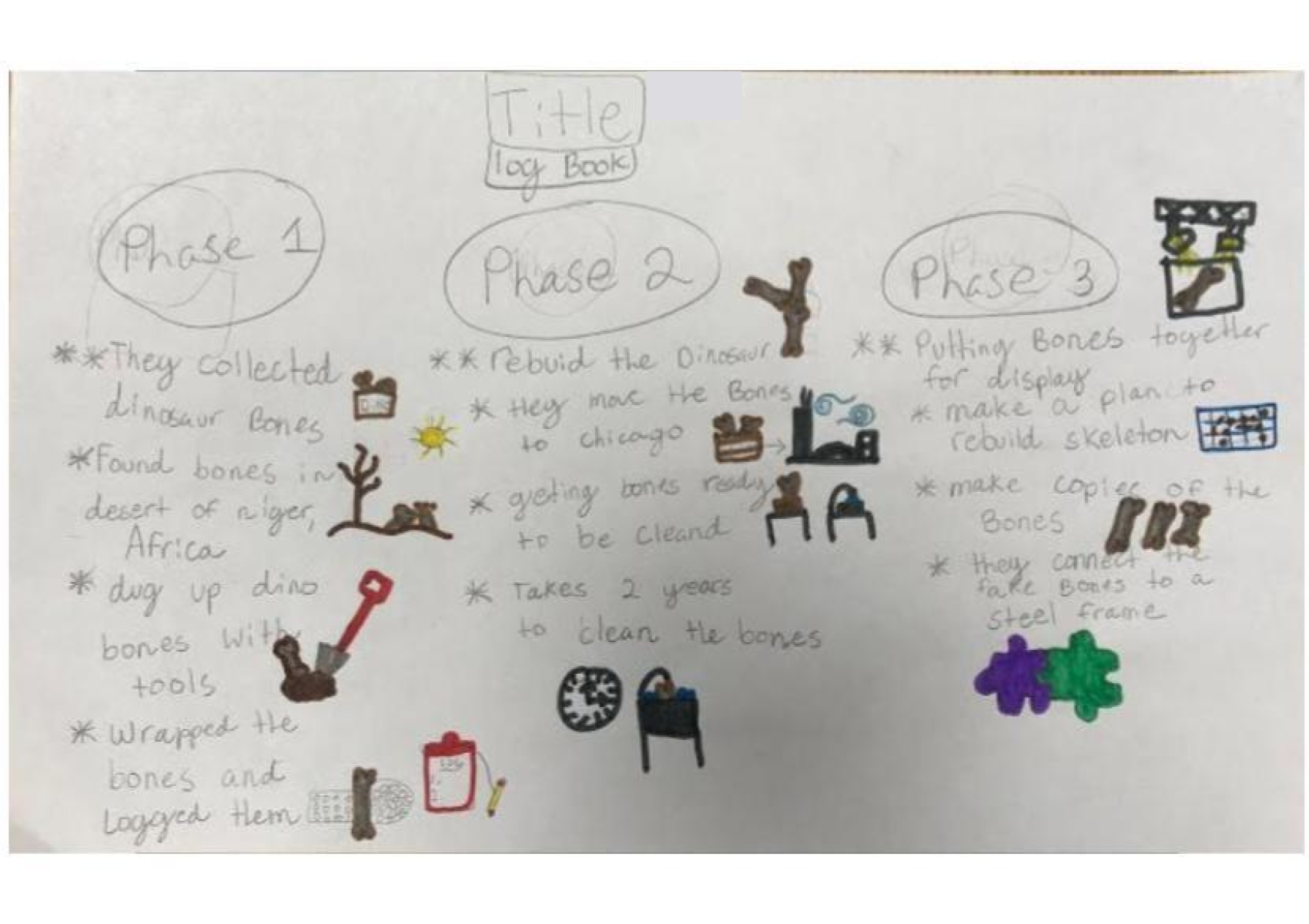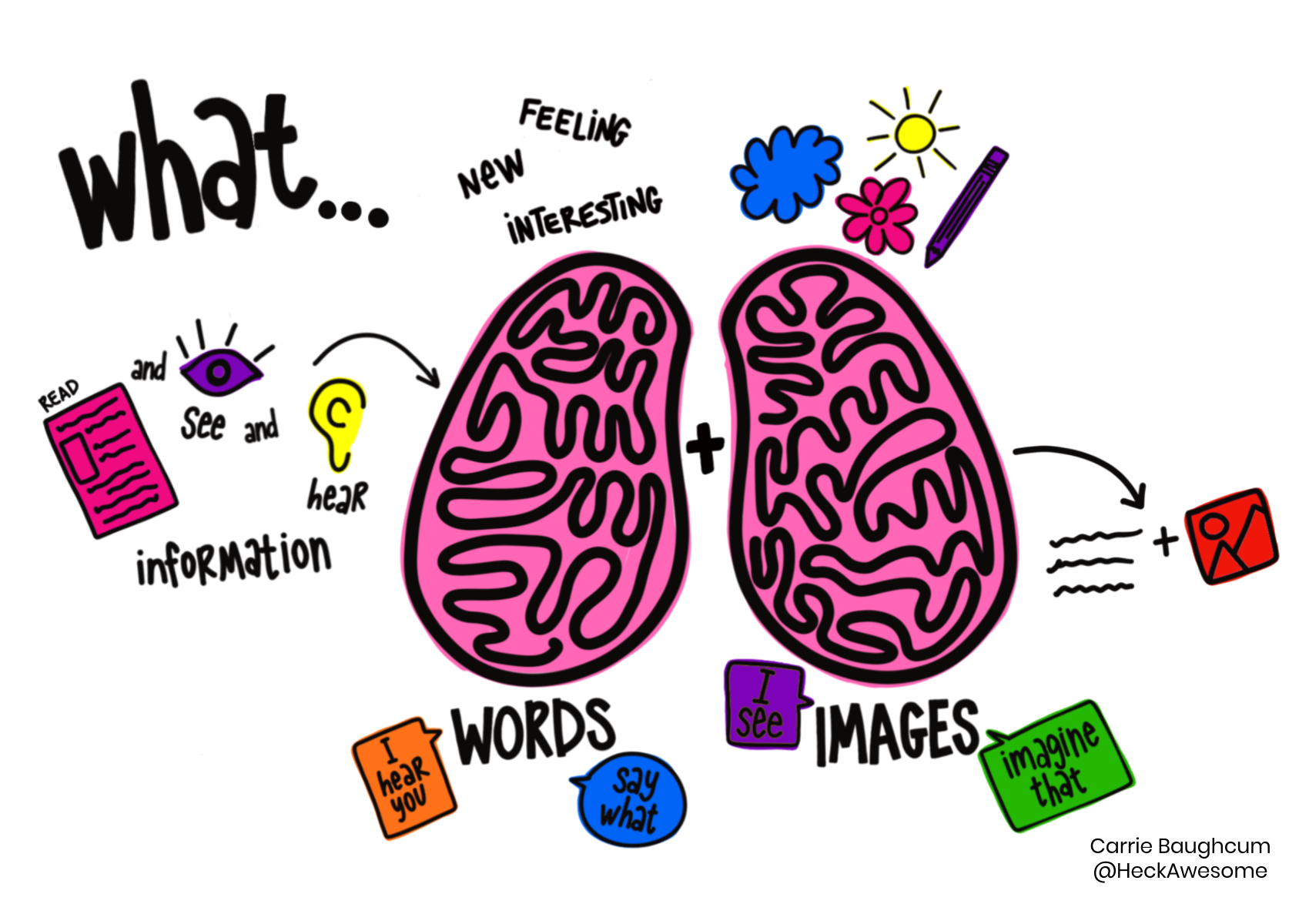Sketchnoting is a powerful tool that can really helps students learn, think, and grow their ideas. We learn and practice this as a tool in our extended class. Take a look....

Once a month, Rayna Freedman’s fifth-graders present their genius hour projects. They get to explore anything that interests them and present what they’ve learned to the class in whatever way they want. Freedman likes genius hour projects because students often get more excited about researching and sharing their knowledge about a topic that interests them. But she was never sure what the other kids were getting out of listening to the presentations.
One day she noticed a student in the back of the class drawing during the presentations. She went over, ready to reprimand him for not paying attention, but instead asked him what he was doing. He explained he doodles what his classmate is talking about to help him remember later. A lightbulb went on for Freedman.
“I thought that if the kids had a way to show me what they were learning, I would know what other kids were getting out of it,” Freedman said during a presentation on how she uses sketchnoting in her classroom at the Building Learning Communities conference.
This first step into doodling for learning has opened up an extensive new classroom practice for Freedman. She’s been encouraging students to take visual notes for only a little over a year, but she’s seen it help some students tremendously. Now she dedicates about five minutes a day for a month to sketchnote practice. She gives students lots of choices in how they want to do it -- on a whiteboard, on a digital tablet, or with paper and pencils. The point is to give them dedicated time to familiarize themselves with how they might express themselves visually.
“I did have students complain about it,” Freedman said. But she told them that if after a month of building up their visual vocabulary and giving it a shot, they wanted to take notes in other ways, that was fine with her. In the end, many of her students chose to sketchnote.
Freedman has come to see sketchnoting as a bridge between early elementary, when students necessarily think visually because they are still learning to read, and middle school, where suddenly all visual thinking seems to stop.
"One of my girls at the end of the year said that, 'I learned that sketchnoting helps me remember things more,' " Freedman said.
Freedman uses sketchnoting resources on the website of Sylvia Duckworth, a former teacher and author who has become a sketchnoting celebrity. Duckworth breaks down the elements of a sketchnote like icons, containers and font to help the artist think about organizing the sketch. Freedman has found those tools help her students organize their thinking as well.
“My students have their own podcast and they sketchnote their segments on notecards,” she explained. Storyboarding in this segmented way allows them to move things around, finding a structure and coherence that doesn’t come as naturally when writing is the first step in the process. “They wouldn’t have been able to do that if it were on paper. They just don’t see it that way.”
She’s also found that allowing students to sketchnote an outline or first draft of a writing assignment can dramatically improve the quality of the thinking and writing she receives. Freedman says her students always want the first draft to be the final draft, and they often write the bare minimum. But when they sketch first, not only do they organize their thoughts better, but they also tend to add more detail and evidence from what they’ve read. They have a template to follow, one that didn’t feel as intimidating to make.
Since the genius project experiment, Freedman has offered sketchnoting as an option to her students in many other ways. She’s found that student sketches are a great jumping-off point to ask them more about their thinking -- they look at what they’ve drawn and can tell her far more than they used to. And, she can easily spot when there are misconceptions.
For example, she quickly realized her students didn’t understand what theme was because, when she asked them to sketchnote the story’s theme, they would draw characters and setting. That was an immediate sign to Freedman she needed to reteach the idea of theme, something she might not have known from the cryptic sentences her students used to write in response to the same kinds of questions.
“It allows me to ask better questions because I’m not just looking at a simple answer or a paragraph,” Freedman said. “I’m trying to interpret what’s in front of me, too.”
Freedman has also found sketchnoting to be surprisingly helpful dealing with the inevitable conflicts that crop up in the middle grades.
“I had these two girls that were up each other's throats,” Freedman said. She asked them to stay in from recess one day, but rather than lecturing them, she asked each girl to sketchnote how she was feeling. Then they each looked at the other person’s drawing and drew what it made them think. The drawings revealed the misunderstanding at the bottom of the conflict, and gave each girl enough emotional distance to truthfully express how they were feeling.
Kim Zajac is the speech and language pathologist at Freedman’s school. She has also found sketchnoting to be a powerful tool for her students. One boy was regularly in conflict with other classmates. Zajac encouraged him to sketch out what happened in those interactions and to imagine and sketch alternative ways to handle it next time.
“Make it less of a criticism process and more of a social expectation process,” Zajac said. This student wouldn’t have been able to talk about how these interactions made him feel without the sketches. They gave him a concrete reference for his feelings and reactions to other kids.
In another instance, Zojac had a student who struggled to keep his speech rate up when he presented. To support him, she first had him explain his ideas to her while she sketched them. Later, when he presented in front of the class, he had the sketch as reference, which helped him stay on track.
“If they can just dump it out, put it in some symbolic form, then it allows them to recall it back, think deeper, and present it in a different form,” Zojac said. And for the kids she supports, who have speech and language issues, sketchnoting offers important insights into their thinking that is otherwise difficult to access.
“It isn’t about things being pretty,” Zojac said. “It’s not about creating a piece of art. It’s about creating a piece of thinking.”
Sketchnoting With Special Needs Students
Carrie Baughcum teaches students with special learning needs at South Middle in Arlington Heights, Illinois. Her students have a range of disabilities from motor challenges, to language challenges, to emotional and behavioral issues. She usually has students for English, math, social studies and a resource class, but they are integrated into other subjects throughout the day. And, as they become more independent learners throughout their time in middle school, they often transition out to the general classroom more often.
Before Baughcum discovered sketchnoting, she used a fairly traditional approach with her students. She was focused on building their comprehension skills and did a lot of skill practice with them. She always saw gains and made solid progress on her students’ Individualized Education Programs (IEPs), but she hadn’t done a lot of thinking about how to get them excited about what they were learning.
Baughcum had begun drawing at home with her daughters as a way of spending time with them. It was an uncomfortable experience for her. She didn’t feel like a good artist, but noticed herself improving as she kept at it. And, she loved the insight she got into her own children’s minds through their drawings.
“I was certain that the students in my special education classroom, two to three years below grade level, that they couldn’t do it,” Baughcum said at the Building Learning Communities conference. But she decided to test the theory one year with a group of students that happened to be all boys.
“It was one of the most challenging groups I’ve had in 20 years of teaching,” Baughcum said.
They were reading an adapted version of Edgar Allan Poe's story, "The Fall of the House of Usher." Baughcum asked her students, “What movie is playing in your head when we read this paragraph?” No one said anything. So, she started narrating out loud what she imagined as she read.

She modeled drawing those thoughts into the margin of the book. Her students dutifully copied down what she had drawn. That went on for a while. Baughcum would walk around the room and ask her students questions about what they were drawing, even though the drawings were copies of what she had described. One day, a student decided to draw something different. Baughcum calls it the “going rogue moment.” It transformed her classroom; overnight every student wanted to show that they imagined something unique.
“Since that moment when he went rogue, all the other students embraced the idea that they had these ideas in their head and we can draw them,” Baughcum said.
Her students didn’t have a lot of experience visualizing, but once she started asking them to do so, and they got comfortable with the idea, Baughcum has seen the practice deepen their comprehension. But, she cautions, it doesn’t always look how she expects. She's even written a guide to sketchnoting in the classroom called My Pencil Made Me Do It.
“Their drawing could be so off base, but if I can go over and ask them about it, and they can connect it, then that’s the right image for them,” Baughcum said. She’s adamant that the drawings themselves are not the point. It’s the thinking behind the drawing that interests her. To keep her students focused on the process and not the product she’s careful to use phrases like “visual thinking” and “doodling to learn.”
Baughcum doesn’t care what the drawings look like, as long as her students can talk about the ideas they represent. She never gives feedback on the drawings themselves, only on the thinking. She often spots misconceptions in the drawings her students have made -- valuable information for her -- but also opportunities to discuss editing the drawing to fill in those comprehension holes.
“The conversations we have in my classroom have become richer,” Baughcum said, and there’s less lag time retrieving thoughts. She points out to students how much cognitive processing is happening as they sketchnote. They’re listening to information, making sense of it, connecting it to other information they know and to a visual image, and then drawing it. It’s an active process, which is why Baughcum has found it to be so powerful for her students.
“That offers this really wonderful desire to want to do it more because they’re feeling good about what they're thinking,” Baughcum said.
Sketchnoting has changed what she expects from her students. But she acknowledges that using this practice in class is a marathon, not a race. It takes time to help students learn how to visualize, to see a picture in their heads. And, she’s worked with them to think carefully about the icons, fonts and containers they’re sketching. She wants them to have a reason for each choice they make in their sketchnote because those choices are directly connected to the material they are learning.
“When we’re sketchnoting in class I tell students is it new, is it interesting, does it make you feel something? If so, it’s probably worth taking down.”
Baughcum also says it’s important for teachers to sketchnote with their students. Drawing can make people feel vulnerable, so when the teacher acknowledges she’s new to this as well, and makes mistakes, it creates room for students to try new things, too.
“Before I started sketchnoting with my students, I wasn’t really a drawer,” Baughcum said. “I have noted that opening up this new permission to draw and learn has opened up opportunities for students to show me parts of themselves they may not have shown before.”

And she’s seen huge successes. Like the first-year student who struggled tremendously with reading. Getting through a whole paragraph was almost impossible for him. But by visualizing the story as it was read to him, doodling in the margins, and connecting the ideas on the first read-through, he could then read it on his own. Baughcum was also quick to point out that students can sketch on Post-it notes pasted into books if they aren't allowed to write in the texts themselves.
“It surprised me that my students, no matter how impaired their cognitive level might be, or their reading level might be, how well their potential to visualize and connect to doodling is,” Baughcum said. She even has students who use assistive technology to write because their motor skills make handwriting very difficult, but they can sketch. And the social worker on her team has picked up on the sketchnoting success to help make social and emotional learning themes more concrete for students as well. Students have created an icon library of their feelings that they use to express their emotions.
Baughcum isn’t suggesting that every teacher drop what they’ve been doing for years to start sketchnoting. But she says if teachers open the door for sketchnoting, even allowing students to sketch as part of another note-taking strategy -- like Cornell notes -- it may be helpful to some students. She thinks of it as a layering strategy. She didn’t stop covering her curriculum to only sketchnote. She gradually exposed her students to different elements of sketchnoting, building up their visualizing capacity and organization skills by practicing it alongside existing social studies or reading activities.
She also says teachers have to be patient with themselves and with their students. Often mindsets are the hardest things to overcome. Baughcum has had students who refuse to draw. But she’s found ways around that. One student was adamant that she could not draw, but Baughcum still wanted her to visualize because she saw how much it helped her other students in their comprehension. She let the student print out pictures and glue them to her sketchnote to make visible her thinking. And ultimately, the girl decided to give sketchnoting a shot after all.
Baughcum says she’s always been a fearless teacher, ready to try anything that might help her students learn. But sketchnoting has stretched her in ways she didn’t know she needed to be stretched. It’s revealed some of her own mindsets about what she believed students with learning disabilities could and couldn’t do. Her students have shown her those beliefs just weren’t true.
“It was never that they couldn’t do it, it was that I never gave it a try to see if they could,” Baughcum said.


Comments
Post a Comment